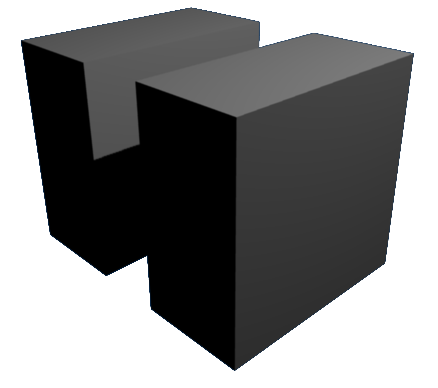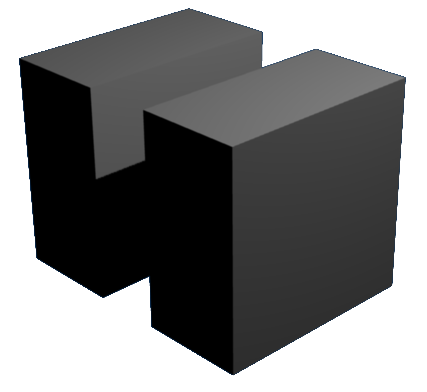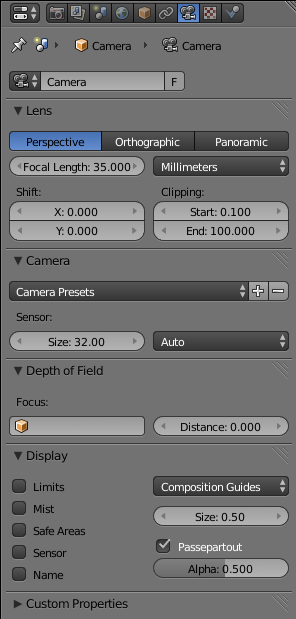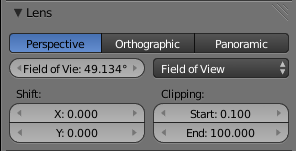Blender 3D:零基础到专业级-单元2:基本建模和着色
Real-World Cameras
::现实世界中的摄像机
Before discussing the camera in Blender, it helps to understand something about how cameras work in real life. We have become accustomed to so many of their quirks and limitations when looking at real photographs, that 3D software like Blender often expends a lot of effort to mimic those quirks.
::在讨论Blender中的相机之前,有助于了解相机在现实生活中的运作方式. 我们已经习惯了它们在看真实照片时的许多特点和局限性,因此像Blender这样的3D软件经常花费大量精力来模仿这些特点.
When taking a photo with a real camera, a number of important factors come into play:
::拍摄照片时, 需要考虑以下几个重要因素:
-
the
focus
— because of the way lenses work, only objects within a certain distance range from the camera (the
depth of field
) will appear sharp in the image. Objects outside this range will begin to appear noticeably blurred, the blur getting worse the farther they are outside the focus range. The narrower the range of in-focus distances (the shallower the depth of field), the more quickly this blurring happens with objects outside it.
::焦点 由于镜头的工作方式,只有在相机与特定距离范围内 (景深) 的物体才会在图像中显得清晰. 距离范围以外的物体会开始显得模糊,焦点范围越远,模糊变得越严重.焦点距离范围越窄 (景深越浅),对外物体的模糊变得越快. -
the
exposure time
— how long the shutter remains open. The longer this is, the more light is captured, but also the more likely the image is to pick up
motion blur
from moving objects.
::曝光时间 快门保持开放的时间. 时间越长,捕获的光越多,但图像也越有可能从移动的物体中捕获运动模糊. -
the
aperture
— how wide the iris opening is. This is expressed, not as an actual distance measurement, but as a fraction of the
focal length
of the lens (loosely, distance between the lens and the image-capturing surface when the image is properly focused), written as
f
: thus, say,
f
/2.8 (“
f
over 2.8”, not “
f
2.8”) is a larger number, hence representing a wider aperture, than
f
/8. A wider aperture increases the amount of light being captured
without
contributing to motion blur, but it reduces the depth of field. The extreme case of a
pinhole camera
has a very tiny aperture with infinite depth of field (no need to focus at all), but captures very little light, so it needs a very well-lit scene, a long exposure, or a very sensitive image-capturing surface.
::光圈虹膜开口的宽度.这表达的不是实际距离测量,而是镜头的焦距 (松散地,镜头与图像捕捉表面之间的距离,当图像正确聚焦时),写为f:因此,比如,f/2.8 (f超过2.8,而不是f 2.8) 是一个更大的数字,因此代表一个更大的光圈,比f/8.一个更大的光圈增加了被捕捉的光量,而不会导致运动模糊,但它减少了景深.极端的情况是,针孔相机具有非常小的光圈,具有无限的景深 (根本不需要聚焦),但捕捉很少的光,所以它需要一个非常明亮的,长的曝光场景,或一个非常敏感的图像捕捉表面. -
the
sensitivity
of the image-capturing surface to light. In the days of film cameras, we talked about film sensitivity (“fast” film being more sensitive to light than “slow” film). Nowadays, with digital cameras we talk about the
gain
of the light-amplification system. High-sensitivity film was more likely to produce a grainy image. In a somewhat similar manner, high light-amplification in a digital camera is more likely to produce a noisy-looking image under low-light conditions.
::图像捕捉表面对光的敏感性.在电影摄像机时代,我们谈论电影敏感性 (快电影对光更敏感于"慢电影).如今,在数字摄像机中,我们谈论光放大系统的收益.高灵敏度的电影更有可能产生颗粒状的图像.在某种程度上类似的,在数字摄像机中的高光放大更有可能在低光条件下产生噪音图像. -
the
field of view
— how much of the scene the camera can see at once. A
wide-angle
lens gives a wider field of view, but you have to be closer to objects to be able to see them, and there is greater perspective distortion. At the other extreme, a
telephoto
lens gives a very narrow field of view, but can take pictures of things from much further away. A wide-angle lens also has a shorter focal length than a narrow-angle one (remember that aperture is expressed as a ratio of the focal length
f
), therefore the telephoto lens is going to capture
less
light than the wide-angle one with the
same
aperture width. You may also have heard of the
zoom lens
, i.e. one with a variable focal length. It can be adjusted from a wide-angle mode to a telephoto mode.
::视野 摄像机能一次看到多少场景. 广角镜头能让视野更广,但你必须靠近物体才能看到它们,并且有更大的视角扭曲. 另一方面,远距离镜头能让视野非常窄,但可以从更远的地方拍摄物体. 广角镜头的焦距也比窄角镜头短 (记住,光圈是以焦距 f 的比率表示的),因此远距离镜头会捕捉比相同光圈宽度的广角镜头少光. 你也可能听说过变焦距离的变焦镜头. 它可以从广角模式调整为远距离模式.
As you can see, many of these different factors interact with each other. The brightness of the image can be affected by the exposure time, the aperture, the gain sensitivity and the focal length of the lens. Each of these have side-effects on the image in other ways.
::像你看到的,这些不同的因素中的许多相互影响.图像的亮度可以受到曝光时间,光圈,增强灵敏度和镜头的焦距的影响.这些都有其他方式对图像的副作用.
Blender and other computer graphics software are, in principle, free of the problems of focus, exposure time, aperture, sensitivity and focal length. Nevertheless, it is common to want to introduce deliberate motion blur into an image, to give the impression of movement. Sometimes it is useful to introduce a deliberately shallow depth of field, blurring objects in the background in order to draw emphasis to the important part of the image, i.e that which is in focus.
::混合器和其他计算机图形软件原则上没有焦点,曝光时间,光圈,灵敏度和焦距的问题.然而,人们通常希望将故意的运动模糊引入图像中,以给出运动的印象.有时有必要将故意的浅景深引入,模糊背景对象,以强调图像的重要部分,即焦点.
Exposure (the total amount of light captured in the image) is also less of a problem in computer graphics than in real-world photography, because in computer graphics you always have total control over the amount and placement of lighting in the scene. Nevertheless, if you’re not careful, you can produce overexposed (bright parts losing detail by saturating to a solid, featureless white) or underexposed images (dark parts losing detail by becoming solid black).
::曝光 (图像中捕捉到的光量) 在计算机图形中也比现实摄影中更少的问题,因为在计算机图形中,你总是完全控制着场景中的照明量和位置.然而,如果你不小心,你可以产生过度曝光 (明亮的部分通过和到固体,无特色的白色而失去细节) 或低曝光的图像 (暗色的部分通过变黑而失去细节).
The field of view issue arises from basic principles of geometry, and Blender’s camera is just as much subject to that as real cameras.
::视野问题源于几何学的基本原理, 混凝土的相机和真实相机一样受此影响.
The Camera In Blender
::在混器中的相机
Here we are going to concentrate on the important issue of
field of view
.
::我们将集中精力研究视野这一重要问题.
You can change the field of view in two ways - move the camera closer to or farther from the scene (called
dollying
in film/TV production parlance), or change the angle of the lens (
zooming
). You do the latter in the Object Data
![]() tab in the Properties window (the Camera has to be selected by RMB in Object Mode, or the required tab will not be visible).
tab in the Properties window (the Camera has to be selected by RMB in Object Mode, or the required tab will not be visible).
::您可以通过两种方式改变视野 - - 将摄像机靠近或远离场景 (在电影/电视制作语言中称为"dolling"),或改变镜头的角度 (放大).您可以在属性窗口中的对象数据选项卡中进行后者 (在对象模式中必须选择摄像机的RMB,否则所需的选项卡将无法显示).
Perspective
is the phenomenon where objects that are farther away from the viewer look smaller than those nearby. More than that, different parts of the
same
object may be at different distances from the eye, leading to a change in the apparent shape of the object called
perspective distortion
. The mathematical theory of perspective was worked out by
Alhazen
in the 11th century, and famously adopted by the Italian Renaissance painters four hundred years later.
::视角是指远离观者较远的物体看起来比附近的物体小.此外,同一物体的不同部分可能与眼睛相距不同,导致物体的形状发生变化,称为视角扭曲.视角的数学理论是由阿尔哈森在11世纪提出的,并被四百年后的意大利文艺复兴时期的画家所采用.
Here are two renders of the same scene with two different cameras, to illustrate the difference.
::这里有两张同一个场景的两张不同相机的染,
This one moves the camera closer but gives it a wider field of view:
::这张照片让相机更近,

This one moves the camera back, while narrowing its field of view, to try to give the scene the same overall size.
::让镜头的整体尺寸保持一致.

The latter is like using a “telephoto” lens with a real camera. Notice how the wider field of view gives you a greater perspective effect. The boxes are all
cuboids
, with parallel pairs of opposite faces joined by parallel edges, yet there is a noticeable angle between notionally-parallel edges in both images, which is more pronounced in the upper image.
That
is what perspective distortion is all about.
::后者就像使用一个"电相"镜头与一个真实相机.注意如何更广泛的视野给你一个更大的视角效果.盒子都是立方体,平行对立面的平行对接并列边缘,然而有明显的角度在两个图像的概念平行边缘之间,这是更明显的在上图像.这就是视角扭曲的全部.
Specifying the Field of View
::指定视野

When you select a camera object, its settings become visible in the Camera Context
![]() in the Properties window, which should initially look something like at right.
in the Properties window, which should initially look something like at right.
::设置在属性窗口中的相机上下文中显示, 起初应该看起来像右边的样子.
Photographers are accustomed to working in terms of the focal length of the lens - longer means narrower field of view, shorter means wider field of view. But the field of view also depends on the size of the sensor (image capture area). Modern digital cameras typically have a smaller sensor size than the exposed film area in older 35mm film cameras. Thus, the focal length measurements have to be adjusted accordingly, in order to give the same field of view.
::摄影师习惯于根据镜头的焦距工作 - - 较长意味着更窄的视野,较短意味着更宽的视野.但视野也取决于传感器的大小 (图像捕捉区域).现代数字相机通常具有比较小的传感器大小暴露的膜区域在旧的35mm片相机.因此,焦距测量必须相应调整,以提供相同的视野.
Blender allows you to work this way, by specifying the focal length in the “Lens” panel, and the sensor size in the “Camera” panel. It even offers a “Camera Presets” menu, which sets the sensor size for any of a range of well-known cameras.
::混合器允许您以这种方式工作,通过在"镜头"面板中指定焦距,并在"摄像头"面板中指定传感器大小.它甚至提供"摄像头预设置"菜单,可以为任何一系列知名摄像头设置传感器大小.
Also, you might be doing compositing of your computer-generated imagery on top of an actual photograph. In which case, to make the results look realistic, you need to closely match the characteristics of the camera and lens that were used to take the photo. If you know the lens focal length and camera sensor size, it makes sense to be able to plug those values in directly.
::另外,你可能在实际照片上对计算机生成的图像进行组合.在这种情况下,为了使结果看起来真实,你需要与拍摄照片时使用的相机和镜头的特征密切匹配.如果你知道镜头的焦距和相机传感器大小,能够直接插入这些值是有意义的.

But if you’re
not
doing photo compositing, but generating completely synthetic imagery, you might consider this a somewhat roundabout way of working. Why not specify the field of view directly as an angle?
::但是如果你不是在做照片合成, 而是完全合成图像, 你可能会认为这是一个有点绕道的方式.
Blender allows for this as well. From the popup menu in the Lens panel that says “Millimeters”, select “Field of View” instead, and the Focal Length field will turn into a Field of View field, showing the angle in degrees directly. This is
much
easier to relate to the geometry of the scene!
::混合器也允许这样做.从镜头面板中的弹出菜单中,选择"视野",焦距字段将变成视野字段,直接显示以度的角度.这更容易与场景的几何关系!
|
|
Relationship between the two: If the width of the sensor is
d
, the focal length of the lens is
f
, and the angle of view is
θ
, then they are related by
.
|
 .
.